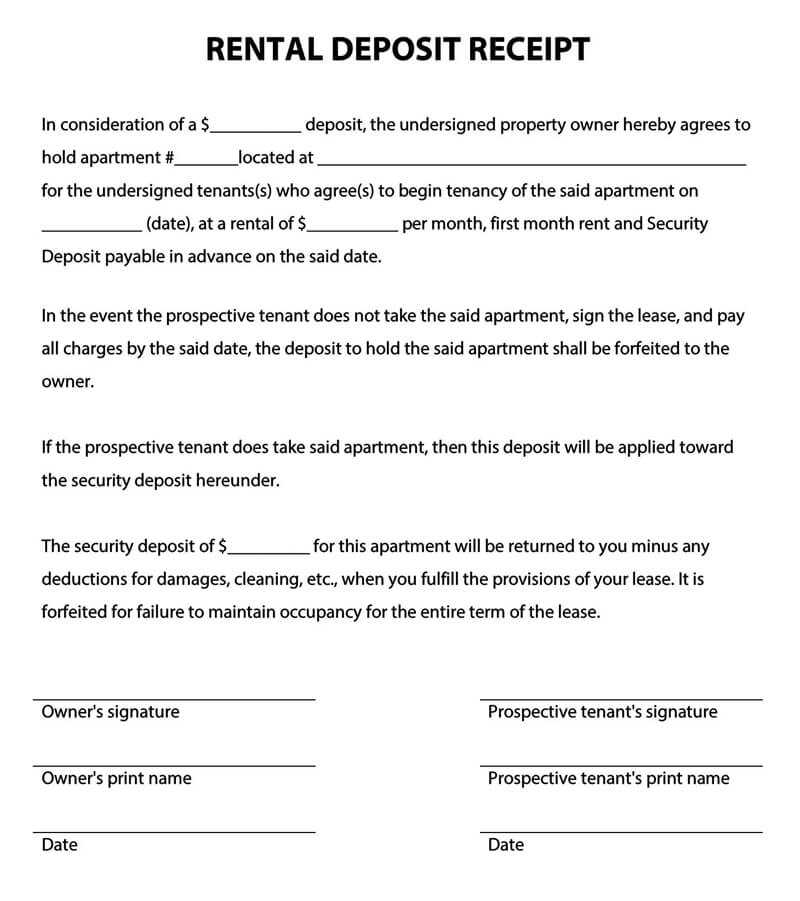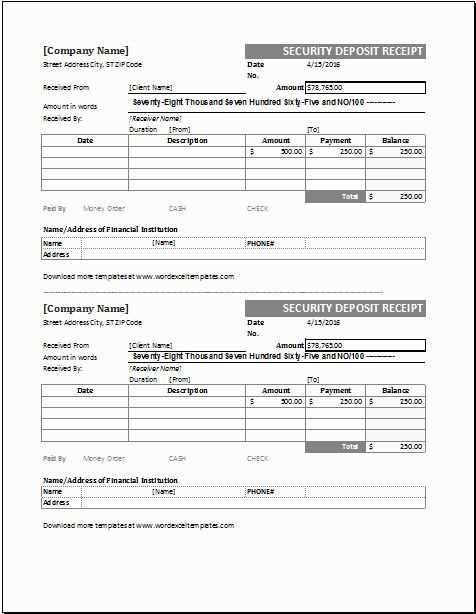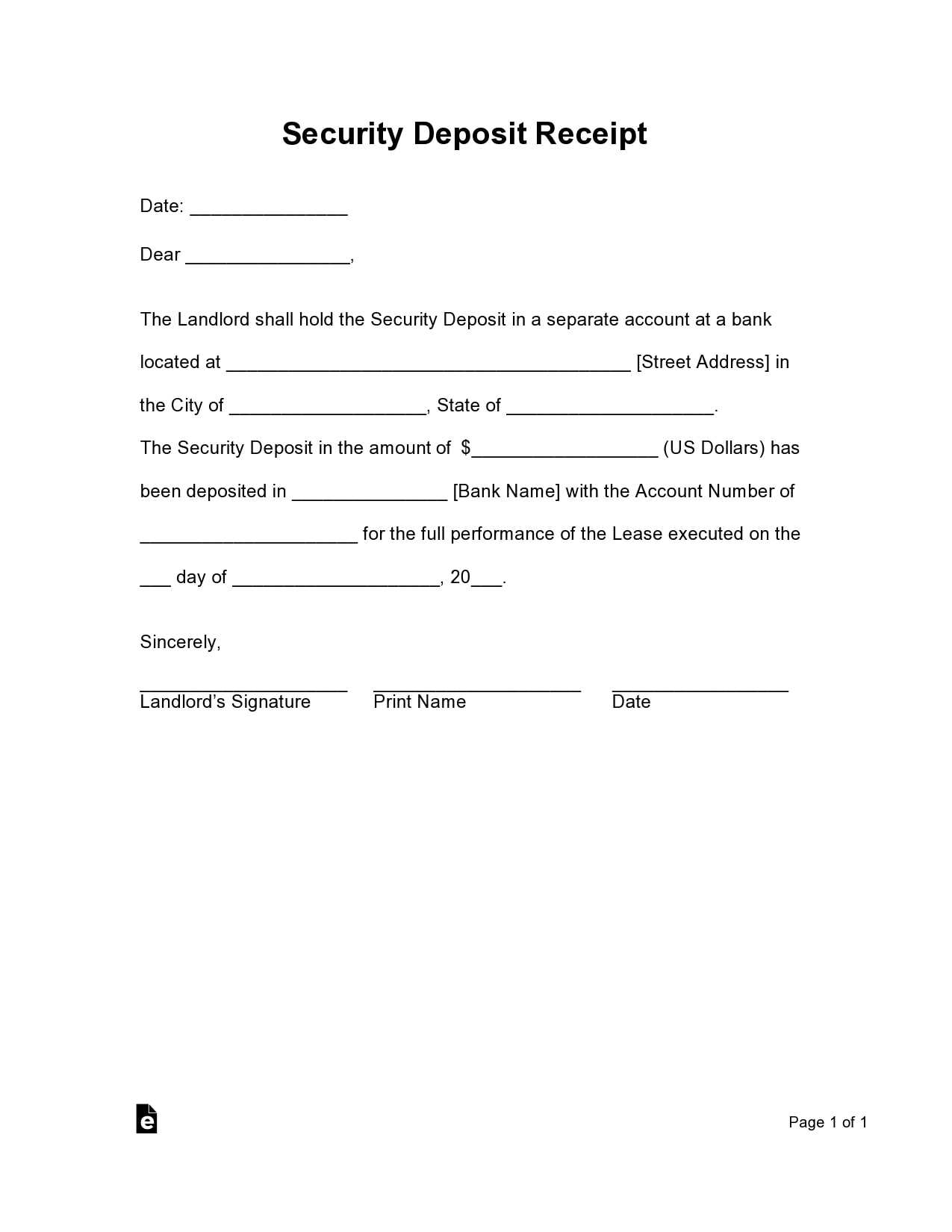For landlords and tenants alike, having a clear, professional receipt for security deposits is a must. This document serves as proof of the transaction and helps ensure both parties understand the terms. With the right template, you can easily create a receipt that is both legally binding and easy to reference. A properly formatted receipt protects both the tenant and landlord in case of disputes.
A good security deposit receipt includes several key pieces of information: the amount paid, the name of the tenant, the rental property address, and the date of payment. It should also clearly state the terms of the security deposit, including any conditions for refunding or withholding the deposit. This transparency is essential to avoid misunderstandings later on.
The Security Deposit Receipt Template DOC is a convenient tool that can save time and effort. Simply fill in the details, and you’ll have a document that can be printed or stored digitally. Using a template ensures consistency and reduces the chance of missing crucial details, which could lead to complications down the road.
How to Create a Security Deposit Receipt
To create a security deposit receipt, follow these steps:
1. Include Basic Information
- Tenant’s Name: Write the full name of the tenant providing the deposit.
- Landlord’s Name: Include the name of the property owner or manager receiving the deposit.
- Property Address: List the address of the rental property where the deposit is held.
- Date of Payment: Specify the exact date the deposit was made.
- Deposit Amount: Clearly state the total amount of the deposit.
2. Define the Purpose of the Deposit
- Security Deposit Purpose: State that the deposit is for securing the rental property and covering potential damages or unpaid rent.
- Refund Conditions: Mention the circumstances under which the deposit will be returned to the tenant.
Double-check all details for accuracy before finalizing the receipt. Both the landlord and tenant should sign the document to confirm the transaction.
Key Elements to Include in a Receipt
Ensure that the receipt clearly lists the date of the transaction. This helps establish a timeline for both parties involved.
Include the name and contact details of the business or individual issuing the receipt. This provides accountability and helps in case of any follow-up.
State the amount paid, along with the currency used. This eliminates any confusion regarding the transaction’s value.
Provide a description of the goods or services purchased. Specify quantities, models, or any distinguishing features to avoid disputes later on.
Highlight the payment method used, such as cash, credit card, or bank transfer. This adds transparency and serves as proof of payment.
Include any applicable taxes or fees. Breaking down these charges ensures clarity on how the total amount was calculated.
End with a unique receipt or transaction number. This allows both parties to track and reference the transaction in the future easily.
Choosing the Right Template for Your Needs
To select the right security deposit receipt template, focus on the specific details required for your situation. Make sure the template includes key elements such as the tenant’s name, address, payment amount, deposit date, and landlord details. Customize the template to reflect your rental agreement terms and the property type.
Consider the following points when choosing a template:
- Clarity: Ensure the template is easy to read and well-structured. Clear sections with proper headings help avoid misunderstandings.
- Customization: Choose a template that allows flexibility to add or remove sections based on your requirements. Templates with editable fields are preferable.
- Legal Compliance: Double-check that the template meets local legal requirements for security deposits. Some areas may have specific wording or clauses that need to be included.
- Design: While simplicity is key, ensure the template has a professional layout that represents your rental business appropriately.
- File Format: Choose a format that suits your needs–Word or PDF are common formats for easy editing and printing. Make sure it’s compatible with your system.
By considering these factors, you’ll find a template that works best for both your rental business and your tenants. Be sure to test the template and adjust it if necessary before finalizing it for regular use.
Common Mistakes to Avoid When Writing a Receipt
Ensure you include the correct date on your receipt. Missing or incorrect dates can lead to confusion and disputes. Always verify the date of the transaction before finalizing the document.
Clearly specify the amount paid. Avoid using vague terms like “full payment” without showing the exact amount. This will help both parties avoid misunderstandings about the payment status.
Don’t forget to list the purpose or description of the transaction. Whether it’s a deposit, rent payment, or another service, clearly state what the payment is for to prevent future confusion.
Include accurate contact information. Omitting the details of the issuer or recipient, such as name, address, or phone number, can make it harder to resolve disputes if they arise.
Double-check the spelling of names and addresses. A simple typo can cause complications later on. Ensuring all information is correct shows professionalism and care.
Avoid using unclear terms. Always use specific and straightforward language. Vague terms like “miscellaneous” or “various” can lead to confusion about the transaction details.
Legal Requirements for Security Deposit Receipts
Security deposit receipts must clearly outline specific details to comply with legal standards. These documents protect both landlords and tenants by ensuring that all expectations are agreed upon in writing.
First, the receipt must state the exact amount of the security deposit, as well as the purpose for which it was collected, such as damage protection or lease compliance. Clearly identifying the deposit amount helps avoid disputes later.
Next, include the names of both the tenant and landlord, along with the address of the rental property. This information ensures there is no confusion regarding the parties involved and the property in question.
The receipt should also outline the conditions under which the deposit will be refunded. For instance, it should mention that the deposit will be returned if the tenant complies with the lease terms, and deductions can only be made for specific reasons, such as property damage or unpaid rent.
Additionally, it is important to state the timeline for returning the deposit. Laws vary by location, but most jurisdictions require deposits to be returned within a specific number of days after the lease ends–commonly between 14 to 30 days.
Some jurisdictions may require a written statement detailing the reasons for any deductions. This ensures transparency and reduces potential conflicts over withheld amounts.
Finally, ensure that the receipt is signed by both parties. This signifies mutual agreement and understanding of the terms outlined. Without signatures, the receipt may not be legally binding.
| Required Information | Explanation |
|---|---|
| Deposit Amount | Clearly specify the amount of the security deposit collected. |
| Names and Property Address | List the tenant’s and landlord’s names and the rental property’s address. |
| Refund Conditions | State the terms under which the deposit will be returned or withheld. |
| Timeline for Refund | Provide the legal deadline for refunding the deposit after lease termination. |
| Written Statement for Deductions | Include an explanation for any deductions, if applicable, in some areas. |
| Signatures | Both the landlord and tenant should sign the receipt. |
How to Modify a Template for Different Use Cases
Adjust the template’s text fields to fit the specific context. For rental agreements, replace general terms with property details like address, amount, and dates. For business transactions, update terms related to payment schedules, services, and agreed-upon conditions.
Adapting for Rent Agreements
Incorporate specific rental terms such as security deposit amounts, rent due dates, and clauses outlining responsibilities of both parties. Be sure to modify contact information for both landlord and tenant and adjust any legal language to match local regulations.
Customizing for Business Transactions
For business-related security deposits, focus on the service or product involved, and the amount to be deposited. Include terms that outline refund processes, payment deadlines, and conditions for the deposit return, ensuring the terms align with the business agreement’s needs.


